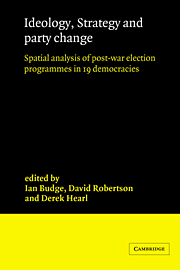 Ideology, Strategy and Party Change
Ideology, Strategy and Party Change Book contents
- Frontmatter
- Contents
- List of Tables
- List of Figures
- Preface
- 1 The influence of election programmes: Britain and Canada 1945–1979.
- 2 The internal analysis of election programmes.
- 3 Britain, Australia, New Zealand and the United States 1946–1981, an initial comparative analysis.
- 4 Canada 1945–1980: party platforms and campaign strategies.
- 5 Sri Lanka 1947–1977: elite programmes and mass politics.
- 6 Israel 1949–1981.
- 7 Ireland 1948–1981: issues, parties, strategies.
- 8 Northern Ireland 1921–1973: party manifestos and platforms.
- 9 Sweden and Denmark 1945–1982: election programmes in the Scandinavian setting.
- 10 The Netherlands 1946–1981.
- 11 Belgium 1946–1981.
- 12 Luxembourg 1945–1982: dimensions and strategies.
- 13 Austria 1945–1978.
- 14 Electoral programmes in West Germany 1949–1980: explorations in the nature of political controversy.
- 15 France 1958–1981: the strategy of joint government platforms.
- 16 Italy 1946–1979: ideological distances and party movements.
- 17 Japan 1960–1980: party programmes in elections.
- 18 Do parties differ, and how? Comparative discriminant and factor analyses.
- Appendices
- General bibliography
- Index
14 - Electoral programmes in West Germany 1949–1980: explorations in the nature of political controversy.
Published online by Cambridge University Press: 27 October 2009
- Frontmatter
- Contents
- List of Tables
- List of Figures
- Preface
- 1 The influence of election programmes: Britain and Canada 1945–1979.
- 2 The internal analysis of election programmes.
- 3 Britain, Australia, New Zealand and the United States 1946–1981, an initial comparative analysis.
- 4 Canada 1945–1980: party platforms and campaign strategies.
- 5 Sri Lanka 1947–1977: elite programmes and mass politics.
- 6 Israel 1949–1981.
- 7 Ireland 1948–1981: issues, parties, strategies.
- 8 Northern Ireland 1921–1973: party manifestos and platforms.
- 9 Sweden and Denmark 1945–1982: election programmes in the Scandinavian setting.
- 10 The Netherlands 1946–1981.
- 11 Belgium 1946–1981.
- 12 Luxembourg 1945–1982: dimensions and strategies.
- 13 Austria 1945–1978.
- 14 Electoral programmes in West Germany 1949–1980: explorations in the nature of political controversy.
- 15 France 1958–1981: the strategy of joint government platforms.
- 16 Italy 1946–1979: ideological distances and party movements.
- 17 Japan 1960–1980: party programmes in elections.
- 18 Do parties differ, and how? Comparative discriminant and factor analyses.
- Appendices
- General bibliography
- Index
Summary
This study is concerned with the nature of political controversy in West Germany as reflected in the election programmes of political parties. What are the basic issue-dimensions? Where are the different political parties located within these? Do parties compete by direct policy confrontation or by emphasizing the importance of different issue-domains? These are the questions addressed in the analysis which carry over from the general theories discussed in Chapter 2, and which are particularly relevant regarding the development of party politics in post-war Germany.
THE INSTITUTIONAL FRAMEWORK
The Federal Republic was established in 1949. The three Western military governors ordered the setting up of a constitutional assembly by 1 September 1948. The leaders of the states were entrusted with the task of drafting a constitution. This work was completed by May 1949 and called the ‘Basic Law’ (Grundgesetz) rather than a ‘Constitution’ (Verfassung) to avoid the appearance of permanence and to underline the division of the country. For the same reason the Basic Law was only ratified by the state parliaments and not directly by the citizens.
There are three major national decision-making structures: the lower house of parliament (Bundestag), the upper house (Bundesrat), and the federal governmnent (Bundesregierung). The federal president (Bundespräsident), who is indirectly elected, serves primarily as the ceremonial Head of State and as a reserve power.
- Type
- Chapter
- Information
- Ideology, Strategy and Party ChangeSpatial Analyses of Post-War Election Programmes in 19 Democracies, pp. 294 - 323Publisher: Cambridge University PressPrint publication year: 1987
- 16
- Cited by


